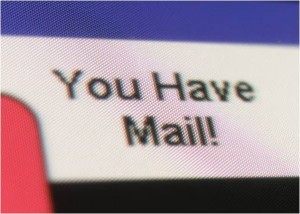 Many small businesses use email marketing to advertise and grow their business. It’s affordable and, when done right, can be incredibly effective. But, email marketing is about much more than just pressing send. With increasingly stringent anti-spam laws and continually evolving technology, it is important to stay up-to-date on the current dos and don’ts of email marketing. So, if you are interested in improving your current program, or ready to start something new, be sure to check out the below list and learn about eight often-made email marketing mistakes, and how to avoid them!
Many small businesses use email marketing to advertise and grow their business. It’s affordable and, when done right, can be incredibly effective. But, email marketing is about much more than just pressing send. With increasingly stringent anti-spam laws and continually evolving technology, it is important to stay up-to-date on the current dos and don’ts of email marketing. So, if you are interested in improving your current program, or ready to start something new, be sure to check out the below list and learn about eight often-made email marketing mistakes, and how to avoid them!
Mistake 1: Not Having Permission
This could sound like a no-brainer, but you should only send marketing messages to people who have opted to receive them. Make it easy to opt-in with a clear explanation of what recipients will get out of your email program. Explain what they can expect, whether that is exclusive offers, informative offers or special savings.
Mistake 2: Mishandling Unsubscribes
Even if people do opt-in to your email program, it’s their right to opt-out at any time. Make unsubscribing easy for them, with an Unsubscribe link in your footer. When someone does unsubscribe, be sure to honor their request promptly.
 Mistake 3: Not Using an Email Marketing System
Mistake 3: Not Using an Email Marketing System
For small businesses just beginning their email marketing programs, selecting an email marketing system, or Email Service Provider (ESP), may not seem like a necessary step. You may think: “I already have an email account. Why couldn’t I just bcc my contacts with a mass email?” The truth is – you really need to use an ESP. Sending mass blind copy mailings through your regular Internet Service Provider (ISP) is a spam trigger and your emails will most likely be blocked. ESPs are remarkably affordable, even for small businesses. Plus, they do the hard work for you. They make it easy for you to stay CAN-SPAM-compliant and they provide you with detailed campaign results, including delivery success rates, email open rates and click-through rates.
Mistake 4: Using Clear Spam Triggers in Subject Lines
Most businesses already steer clear of known spam trigger words, however, since it is continually updated, it never hurts to take a look. Check out a list of common spam trigger words – and then avoid using them!
Mistake 5: Not Using Alternative Text
Many email clients block images in your emails by default. Therefore, unless your email content is entirely text-based, your images may not show up in your subscribers’ emails unless they download the images. A best practice in email marketing is to always include alt attributes, commonly known as ALT tag or ALT text, which stands for alternative text. So, add in pertinent descriptor text (if your image says, “Follow us on Twitter,” so could your ALT tag) and ensure that your subscriber will at least know what the email is about, even if images are disabled.
 Mistake 6: Lacking a Call to Action
Mistake 6: Lacking a Call to Action
You went to all the trouble of creating and sending an email; make sure people know what you want them to do as a result of your message. By including a clear and distinctive call to action, you can help your subscribers take the next desired step. A prominent “Click Here” button or burst that calls attention to where you want someone to click works well, as do links within the text and images. And, don’t wait until the very end to highlight the offer. Be sure there are several places above the message fold that a subscriber can easily click.
Mistake 7: Not Testing Before Deployment
No email marketing program can be successful without testing. Test your subject lines, test your call to actions, test offers and test timing – and that’s for starters. Every email program’s subscribers act differently, depending on your industry and subscriber demographics. Many ESPs allow you to easily perform A/B tests on subject line, message content and deployment timing. And then, once you have some actionable data as a result of your testing, just remember to act on it!
Mistake 8: Sending Too Often
You work hard to build your email subscriber base. Don’t annoy those precious subscribers by sending them too many emails! Test and establish a cadence or rhythm to your email sends, be it once a month, twice a month, weekly, or even a special timing that may work for your base. And, remember: if you promise to only email subscribers once a week, honor that. Don’t send daily emails if you clearly promised weekly messages.
Are there any mistakes you would add to the list? Let us know in the comments below!
